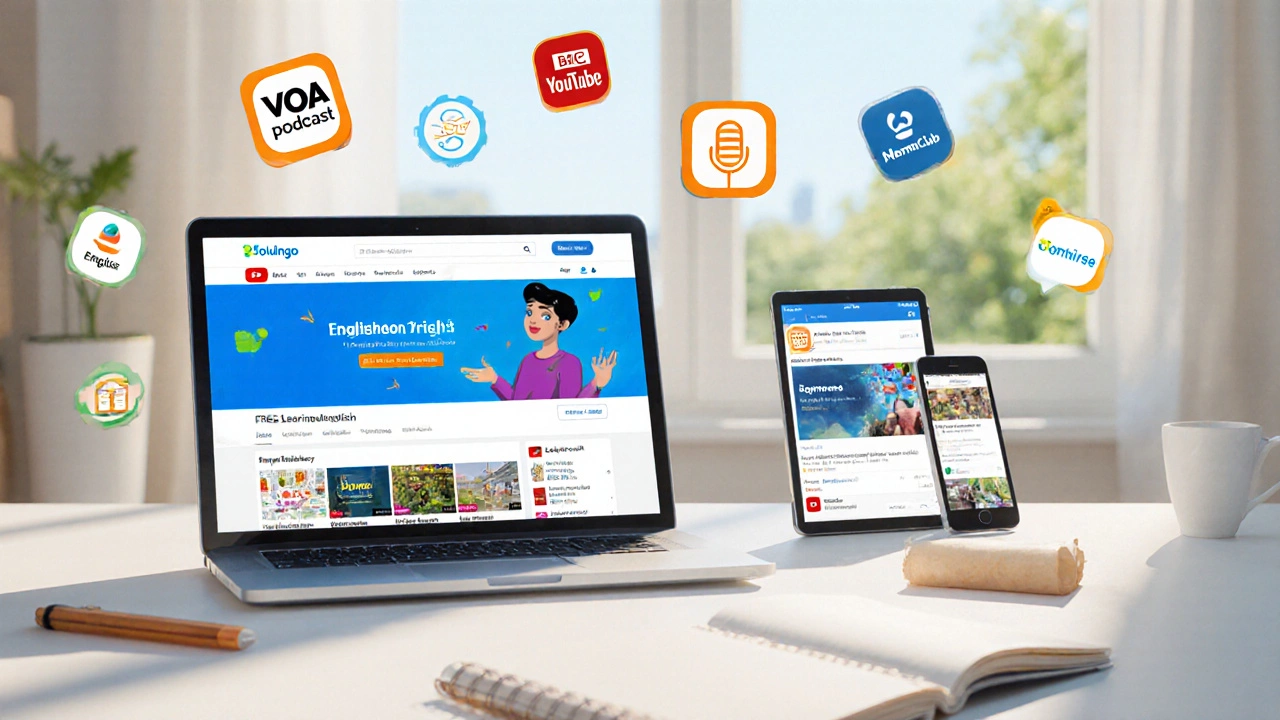
Learn Basic English – Your Quick‑Start Guide
When working with basic English, the foundational skills of reading, writing, listening, and speaking in the English language. Also known as English basics, it offers a practical entry point for anyone aiming to communicate confidently in everyday situations. Learn basic English isn’t a magic trick; it’s a steady mix of exposure, practice, and the right tools. Think of it as building a house: reading is your foundation, writing the walls, listening the roof, and speaking the doors that let you move in and out. The moment you grasp that each skill supports the others, you can plan an efficient study routine that targets all four parts at once.
Self‑Study English: Building the Routine That Sticks
For most learners, self‑study English is the most flexible route. self‑study English, a learner‑driven approach that mixes free resources, apps, and daily habit formation lets you fit practice into any schedule. Start with a 15‑minute reading slot each morning—news headlines, short stories, or even captions on social media. Follow with a quick listening drill: a podcast episode at 1x speed, then replay tricky parts at 1.5x. Write a one‑sentence summary of what you heard; this bridges listening and writing. Finally, speak aloud, mimicking the speaker’s intonation. The key attribute here is consistency: a 10‑minute daily habit beats a four‑hour marathon once a month.
Tools matter, too. Language‑learning apps like Duolingo or Memrise give bite‑size vocab practice, while YouTube channels such as “English with Lucy” supply clear pronunciation models. The micro‑learning format matches how our brain retains new words—short, spaced repetitions. Pair that with a notebook where you jot down unfamiliar phrases, then review them weekly. This simple loop of input, output, and review creates a self‑reinforcing cycle that speeds up fluency.
Another vital attribute of self‑study English is personalization. Choose topics you love—sports, cooking, tech—and seek materials in those areas. Your interest fuels motivation, which in turn boosts retention. When you hear a phrase you’re excited about, you’re more likely to repeat it, turning passive exposure into active usage.
Remember, self‑study doesn’t mean you’re alone. Online forums, language‑exchange platforms, and study‑buddy groups provide feedback and keep you accountable. The moment you share a paragraph you wrote or a recording of your speech, you get concrete suggestions that fine‑tune your skills.
All these elements—consistent micro‑sessions, targeted tools, personal interests, and community feedback—combine to make self‑study English a powerful engine for mastering basic English quickly.
Now, let’s talk about turning that foundation into real‑world confidence.
English speaking is the skill that most learners dread, but it’s also the one that delivers the biggest payoff. English speaking, the active production of spoken language, built on vocabulary, pronunciation, and spontaneous thought bridges the gap between knowing and using. The biggest obstacle is fear of mistakes, yet research shows that speaking errors are natural stepping stones. The more you speak, the faster you correct those errors through feedback.
Start with shadowing: pick a short video clip, play it at normal speed, and repeat each sentence immediately after hearing it. This mirrors native rhythm and trains muscle memory. Next, move to “talking aloud” with yourself—describe your daily routine, narrate what you’re doing, or summarize a news article. Recording these attempts lets you catch pronunciation slips you might miss in real time.
To push beyond the mirror, join a language‑exchange session on platforms like Tandem or HelloTalk. These apps pair you with native speakers who want to learn your language, creating a win‑win scenario. Set a clear goal: five minutes of introduction, ten minutes of Q&A, and a wrap‑up recap. This structure keeps conversations focused and reduces anxiety.
Speaking also benefits from a solid listening base. When you hear words in context, you internalize stress patterns and intonation, making it easier to reproduce them. So, combine listening drills with speaking practice for a synergistic effect.
Finally, celebrate small wins. Each successful sentence, each clarified pronunciation, each conversation that lasts a minute longer than before—these markers track progress and keep motivation high.
Alongside speaking, two other pillars deserve equal attention: listening and reading.
English listening, the skill of understanding spoken language through exposure to varied accents, speeds, and contexts fuels both speaking and comprehension. Begin with content you enjoy—movies, podcasts, music. Use subtitles initially, then wean off them as confidence grows. Active listening means pausing, noting down unfamiliar words, and repeating sections until they make sense. Over time, you’ll notice improved speed and reduced reliance on visual cues.
Reading, meanwhile, expands vocabulary and reinforces grammar structures. English reading, the process of decoding written text to extract meaning, a cornerstone of language mastery should start simple: children’s books, graded readers, or news articles with limited jargon. Highlight new words, guess meanings from context, then verify with a dictionary. This habit turns passive reading into active learning.
Both listening and reading share a common attribute: input density. The more varied the input, the richer your mental lexicon becomes, which, in turn, supports smoother speaking and writing. Mix genres, switch between formal and informal tones, and expose yourself to different accents—British, American, Australian—to build a flexible understanding.
Putting it all together, basic English is a network of interlocking skills—reading, writing, listening, speaking—each reinforcing the other. By structuring self‑study, practicing speaking with real partners, and diversifying listening and reading material, you create a robust learning ecosystem.
Below you’ll find a curated list of articles that dive deeper into each of these areas, from step‑by‑step self‑study guides to practical speaking drills and resource round‑ups. Use them as shortcuts, checklists, or inspiration to fine‑tune your own study plan.
